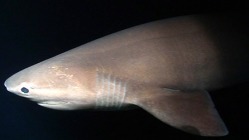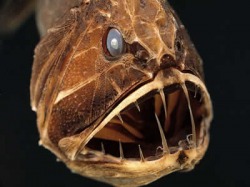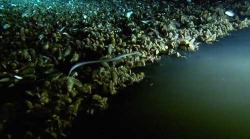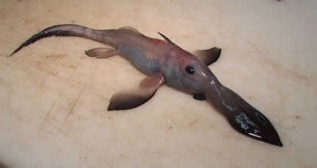 Sixgill Shark Another video of the rare Sixgill shark, so called because it has... well you get the picture. Featured before on Show Me Something Interesting, the sixgill seems to be one of your favourites, so here is another chance to see it. This time, the video is from the BBC Wildlife team with Kate Humble. The sixgill usually grows to about 15 feet, but the one in this video is about 20 feet long. Watch it go for the tuna bait that was left by the team. Also, check out the dorsal fin: it's smaller and much further back than usual.
0 Comments
 The Fangtooth The Fangtooth The Fangtooth gets its name from its, well, fangs. They are, according to Sir David Attenborough, the biggest teeth relative to body size in the ocean. It has special cavities, which extent either side of its brain, to house the teeth when its jaw is shut. Because they are so ugly, they are also know ans Ogrefish. Their real name is Anoplogaster cornuta, and is from the family Anoplogastridae. They have been found as far down as 16,000 feet, which is one of the deepest descents of any ocean creature yet known. It is so resiliant, that scientists have managed to keep specimines alive for months in tanks inspite of the massive difference in pressure from its natural habitat. Do keep an eye out at the begining ofthe video for a quick shot of the Dumbo Octopus.  Underwater Brine Pool Underwater Brine Pool Another interesting clip from David Attenborough's The Blue Planet: here we see an underwater lake with its own shoreline of muscles. How can this be? Well, it's all to do with the composition of the lake. The liquid in the lake is Brine. Brine is a solution of salt in water where the saturation level is much higher than that usually found in the sea. Because the Brine is heavier than the surrounding sea water, it sinks, and forms pools and lakes at the bottom of the ocean. The pool in the video is in the Gulf of Mexico. This pool was formed when, during the middle Jurassic period, a part of the ocean became cut-off from the main body of water. This then evaporated, leaving behind a high concentration of salt. When normal tectonic movements caused the area to flood, a process called salt tectonics occured, which eventuated in salt being released into the ocean water, and forming a heavy liquid layer layer on the ocean floor. The reason for the shoreline of muscles is that Brine often contains high levels of Methane, which the muscles can process into into energy. These muscles are contain bacteria which are known as Chemoautotrophs: organisms which produce energy by Chemosynthesis. Chemosynthesis is a process where carbon, taken usually from Carbon Dioxide or Methane, is converted into organic matter by the oxidation of inorganic compounds, usually Hydrogen Sulphide, but sometimes by Hydrogen gas. It is this process that allows tube worms to extract energy from the Hydrogen Sulphide produced by ocean floor vents.  Rhinochimaeridae Rhinochimaeridae Here's another weird and wonderful denzien of the oceans for you to to look at: Rhinochimaeridae, or the Long-Nosed Chimera fish. In South Africa, it is also known as the Ghost Shark. This fishy lives from 200 to over 2,000 meters below sea-level, nearly 8,000 feet down in the abyss. The long nose has many sensory endings used to locate small fish for it to eat. It also has a poisonous spike protruding from the first dorsal fin, which is mildly toxic and thought to be for defence purposes. Very little seems to be known about these odd fish, but here is a link to a scientific paper which gives info about all of the Chimera order. Happy fishing! |
MOST VIEWED POSTS
© James Edward Hughes 2013
 RSS Feed
RSS Feed





